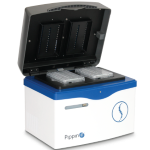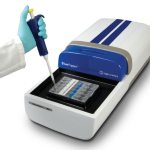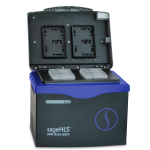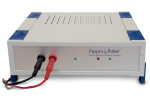London Calling: Who Will Beat the 1 Mb Read?
Later this week, scientists will descend on Old Billingsgate, London, for Oxford Nanopore’s annual user event. Better known as London Calling, the meeting has become famous for talks full of cutting-edge nanopore sequencing results, novel protocols, and best practices. The information exchange at London Calling has helped take nanopore sequencing technology from something only a few labs could perform well to a platform that’s now far more robust and reliable for a broad range of applications.
Sage is delighted to be attending London Calling this year. We enjoy getting to know the Oxford Nanopore users, many of whom are implementing our automated DNA size-selection tools to extract the longest possible reads from their sequencers. (For a great example, check out this new app note.) By removing the smallest fragments from libraries ahead of time, sequencers can be directed to focus on the molecules most likely to yield those record-shattering read lengths. The current record for a single continuous read is more than 1 Mb, but we’re willing to bet that this year’s London Calling users will be ready to beat it.
App Note: BluePippin Sizing Yields Longer MinION Reads
BluePippin users are generating longer reads from their Oxford Nanopore MinION sequencers, as demonstrated in a new app note from our colleagues at Nippon Genetics. The app note showcases a workflow used by Kazuharu Arakawa, an associate professor in the Institute for Advanced Biosciences at Keio University in Japan.
The app note describes an experiment performed on DNA extracted from the leg of a golden silk spider. Sample prep included size-selection with a BluePippin instrument to remove the shorter library fragments that would otherwise limit the amount of data produced by the MinION nanopore sequencer. As the app note points out, this step must be handled prior to library prep, during which electrophoresis-sensitive tethers are added.
According to Dr. Arakawa, “Size selection using BluePippin allowed us to remove short reads and perform effective sequence of long-chain DNA fragments, compared to using samples not size selected.”
geXc Boston: Check Out This Free Symposium on Computational Genomics
If you’re in the Boston area, don’t miss this Friday’s one-day symposium on genomics and computational biology at the Broad Institute. Organized by the Genomic Exchange Community, this geXc (pronounced “jexy”) event will bring together speakers from academia and industry to offer updates on everything from the microbiome and data analysis to genome modeling and population studies.
Sage is proud to be a sponsor of geXc Boston. Our own Jun Zhou, a senior scientist, will be giving a talk about using the HLS-CATCH method for targeted, long-range sequencing of large genomic elements. The event is free to attend and includes giveaways of an Oxford Nanopore MinION and an Apple Watch. We hope to see you there!
ABRF: Tech Lovers Head to Myrtle Beach for Core Lab Meeting
Conference season is going strong. Next on our list: the annual meeting of the Association of Biomolecular Resource Facilities in Myrtle Beach, S.C. We never miss this conference — it’s a great event for tech-loving life science people like us. ABRF brings together hundreds of core lab managers from around the world to share novel protocols, results of instrument bake-offs, and best practices.
At ABRF, scientists offer a different perspective on tools than we get from individual researchers. Core labs have to run technologies at near-industrial capacity, with tons of effort going toward nailing down workflows and automation for the most consistent, reliable results possible. Many of the great advances in our area of interest, NGS sample prep, have come from the dedicated and methodical core lab scientists in this community. At this year’s conference, we’ll be attending many sessions in the genomics track, which will include presentations on single-cell sequencing, clinical NGS, CRISPR, and bioinformatics.
We’re also looking forward to the high-level talks. Amos Bairoch from the Swiss Institute of Bioinformatics will be honored with the 2018 ABRF Award Lecture for Outstanding Contributions to Biomolecular Technologies, a talk that promises to cover highlights from a remarkable career in protein analysis. There will be an interesting opening keynote address from Howard McLeod of the Moffitt Cancer Center entitled “Precision Medicine: Nice Start, But A Long Way to Go.”
If you’ll be attending ABRF, please stop by booth #103 in the exhibit hall to visit the Sage team. We’d be happy to learn about your core lab and help you determine whether our automated DNA size selection instruments could be of assistance. And don’t miss poster #128, “Faster DNA Size-Selection for Long-Read Sequencing,” for a sneak peek at the new High-Pass Plus cassette for shorter run times and larger input samples on our BluePippin system.
Join Us at the Upcoming Long-Read Workshop at Jackson Lab
Long-read sequencing is steadily gaining traction as scientists realize its value for resolving regions of the genome that are intractable with short-read methods. From structural variants to repetitive or GC-rich regions, many clinically important stretches of the human genome just aren’t a good fit for traditional Illumina or Ion Torrent platforms.
That’s why we’re really pleased that The Jackson Laboratory for Genomic Medicine is hosting a new Long-Read Sequencing Workshop next week to help scientists understand protocols and strategies for using these tools. Held at the Farmington, Conn., location, the event features a who’s who of long-read pioneers presenting tutorial information about genome assembly, structural variant identification, variant phasing, and more. Attendees will also hear from scientists at PacBio, 10x Genomics, and other leading players in long-read and long-range technologies.
Long-read platforms offer unique sample preparation challenges, and our automated DNA size selection instruments have become a crowd favorite for maximizing the read lengths they generate. Sage is a proud sponsor of the workshop, and our CSO Chris Boles will also be giving a talk about Cas9-assisted sample prep strategies for long-read sequencing. We’re particularly looking forward to touring the new sequencing center and research facility.
We hope to see you there!





